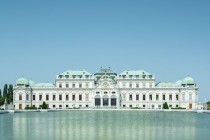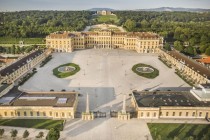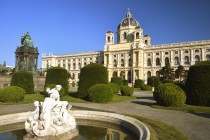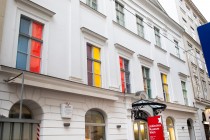| Austria |
Vienna |
Belvedere |
56. |
618 |
|
|
Art
|
More |
The collection of paintings stored at Belvedere was made publicly available in 1781. Currently, art collections are presented in Lower Belvedere, Upper Belvedere and Belvedere 21. They cover works of art from the Middle Ages to the present day. The attention of visitors is attracted by the world's largest collection of Gustav Klimt's paintings.
Belvedere Palace © Lukas Schaller / Belvedere, Vienna
|
| Austria |
Vienna |
Schönbrunn Palace |
89. |
716 |
|
|
Historic house
|
More |
Schönbrunn Palace was the main summer residence of the Habsburg rulers. The palace was built in the 17th century, rebuilt in 1740–50 during the reign of Empress Maria Teresa in the Rococo style. The museum in the palace was opened to the public in 1919. There are 1441 chambers in the palace, of which 45 are open to the public. It covers an area of about 186 hectares.
Schönbrunn Palace © Schloss Schönbrunn Kultur- und Betriebsges.m.b.H., Severin Wurnig
|
| Austria |
Vienna |
Kunsthistorisches Museum |
97. |
253 |
|
|
Art
|
More |
Kunsthistorisches Museum (KHM) opened in 1891.
Most of the collections are the collections of the imperial Habsburg family. The collections are divided into a gallery of paintings, art of ancient Egypt, Antikensammlung, Kunstkammer, Münzkabinett, and a library. KHM presents paintings for example: Raphael, Dürer, Titian, Caravaggio, Rubens, Rembrandt, Velázquez.
©KHM-Museumsverband
|
| Austria |
Vienna |
St. Stephen's Cathedral |
209. |
236 |
|
|
Temple
|
More |
St. Stephen's Cathedral (Domkirche St. Stephan) is the third temple erected on the same site from 1137 to 1511. The Gothic cathedral with older Romanesque elements is built of limestone.
Length 107 meters, width 70 meters, height 136.7 meters.
Inside, numerous altars are stored, including the Baroque main altar and the Gothic Wiener Neustadt Altar, the Gothic tomb of Emperor Frederick III, and the late-Gothic sandstone pulpit.
|
| Austria |
Vienna |
Natural History Museum Vienna |
301. |
261 |
|
|
Natural history
|
More |
The Natural History Museum (Naturhistorisches Museum Wien, NHM) opened to the public in 1889.
The entire collection consists of about 30 million objects. Of which over 100,000 objects are on display in 39 rooms with an area of 8,460 square meters.
The collection includes, among others:
- the Venus of Willendorf, about 29,500 years old
- a sea mermaid that became extinct more than 200 years ago
- dinosaur skeletons such as diplodocus, allosaurus and iguanodon
- complete skeletons of large mammals, such as Deinotherium (hoe tusker)
- the largest and oldest meteorite collection in the world, with the Martian meteorite "Tissint"
© NHM Vienna, Kurt Kracher
|
| Austria |
Vienna |
Albertina |
304. |
305 |
|
|
Art
|
More |
Albertina established in 1805.
Its collections include about 65,000 drawings and about 1 million graphics and photographs, including works by Dürer, Rembrandt, Rafael, Schiele, Cézanne, Picasso, Matisse, Klimt, and Kokoschka. Albertina Modern has been open to the public since 2020, bringing together over 60,000 works by 5,000 artists.
|
| Austria |
Vienna |
Jewish Museum Vienna |
382. |
231 |
|
|
Culture History
|
More |
The Jewish Museum of the City of Vienna is a place of encounter, interaction and understanding, which seeks to raise awareness of Jewish history, religion, and culture.
The first Jewish museum in the world was founded in Vienna in 1895, sponsored by a group of Viennese Jewish citizens. The collection focused on the culture and history of the Jews in the Austro-Hungarian Empire, particularly Vienna and Galicia.
In the interwar years Zionist objects were added, reflecting the new political discussion at that time.
The museum was closed by the Nazis in 1938 directly after the Anschluss. In the last year of its existence the inventory listed 6,474 objects. In 1939 the museum collection was transferred to the Museum of Ethnology and other institutions in Vienna. The Anthropology Department of the Natural History Museum in Vienna used some of the items for its anti-Semitic propaganda exhibition “The physical and psychological appearance of the Jews".
Most of the objects were returned to the IKG Vienna in the early 1950s, although some were not restituted until the 1990s. Over half of the objects have disappeared; it is practically impossible to discover whether they were stolen or deliberately destroyed. Objects once listed in the Jewish Museum collection turn up occasionally on the art and antiques market. The surviving objects – on permanent loan from the IKG to the present-day Jewish Museum Vienna – form a unique component of the current collection.
|




